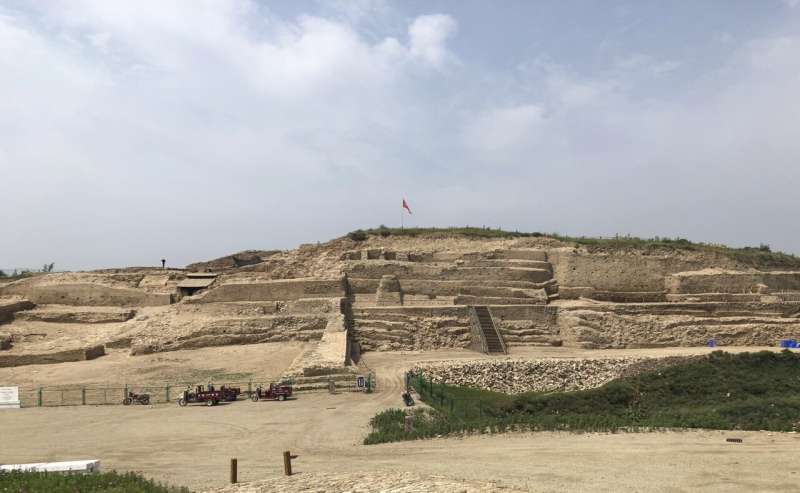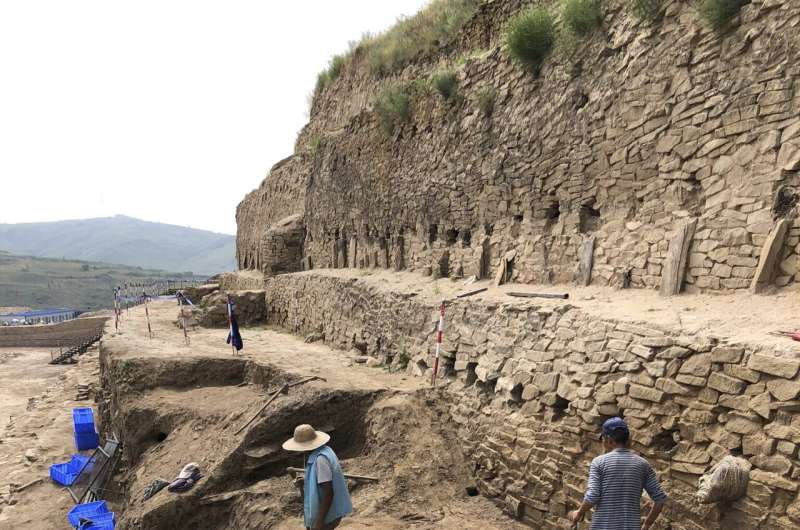August 5, 2024 feature
This article has been reviewed according to Science X's editorial process and policies. Editors have highlighted the following attributes while ensuring the content's credibility:
fact-checked
trusted source
proofread
Ancient Chinese bone needle workshop reveals industrial practices of the 2nd millennium BCE

Recent excavations at the Shimao site in Shaanxi, China, have revealed one of the earliest and, so far, largest bone needle workshops ever discovered. The research published in the Journal of Anthropological Archaeology by Hua Wang and colleagues provides valuable insights into craft specialization and early state formation in China during the transition from the Neolithic to the Bronze Age (ca. 2nd millennium BCE).
The site, situated at the contact zone between the Loess Plateau agropastoralists and the Mongolian Plateau herder/hunter–gatherers, was excavated between 2016 and 2018, revealing stonewalling, ceremonial structures and a massive stone terrace mound.
The Shimao site operated during a critical transitional phase in China. According to Dr. Li Min, one of the researchers working at Shimao, the Shimao workshop was "the first specialized workshop for the mass production of bone tools in Chinese archaeology. Previously, Neolithic bone tool production was small scale and general purpose. The Shimao workshop, which dates to the critical transition era to the Bronze Age, displays the beginning of the industrial production observed in later Bronze Age cities."
The site consists of three major components: the outer enclosure, the inner enclosure, and the central mound, called Huangchentai (royal terrace). The bone needle workshop was located at the top of the mound, among elite residences, temples, guardhouses, stone reliefs, and petroglyphs.

For Dr. Li Min, the location of the workshop at the top of the mound is particularly intriguing. "For me, the unexpected finding is the location of the production on top of the central mound, associated with ritual architecture and possibly palatial buildings. This association shows a close-knit relationship between needle production, which probably served garment production, and the ritual authority at Shimao.
"I think that Shimao was a pilgrimage center and the silk, hemp, and sheep-skin garments produced on the central mound were likely shamanistic costumes, adorned with cowrie shells, turquoise beads, and small copper accessories. The abundant presence of microlithic tools indicates northern contribution to the florescence of this Highland Longshan ritual center."
During the workshop's excavation, more than 18,759 pieces of finished and semi-finished bone were recovered, among them more than 16,137 bone needles. The majority of the bone artifacts had been made using caprine (sheep/goat) bones, specifically metapodia, due to their long, straight nature. These bones were sourced from the remains of ritual sacrifice as well as from general consumption.
According to Dr. Li Min, "I think the massive presence of sheep bones (estimated at 400,000 animals) were produced by the ritual activities and feasting activities (as well as daily consumption) that took place at Shimao as a pilgrimage center."
While needles could be made from other materials, bone was chosen due to its dense and smooth nature says Dr. Li Min. "These bone needles are dense and smooth. It is a choice made by Neolithic and Bronze Age societies around the world."
Interestingly, needle production was rather unstandardized, and needles came in a variety of sizes, shapes, and widths. This diverse range of needles meant they were suited for use at different stages of textile production and could be used on different textiles, be they silk or leather.
The semi-standardized nature of the needles, compared with the more standardized use of almost exclusively one type of animal species, speaks to the workshop's use during a period of transition.
During the Neolithic, unstandardized household levels of bone needle production were common, with needles being produced from a wide range of animals. But during the Bronze Age, needles were produced at an industrial level, and the same species was used for production. The Shimao workshop does both, making it a critical prelude to the bone workshops found later in the Bronze Age.
Craft specialization, like the one at Shimao, offers insights into ancient economies, how they were formed and operated. For Shimao, many questions are still unanswered; for example, were the bone needles produced for daily use by Shimao's inhabitants, or were they part of a trade network supplying surrounding communities? Why was the workshop located on top of the mound in such a prestigious location? Could it have been a site of pilgrimage, and if so, why?
Some of these questions are hindered by a lack of data, says Dr. Li Min, "We do not have sufficient data to study the distribution of the needle products in the region yet." However, future excavations may remedy this and provide more insights into the more enigmatic period of transition between the Neolithic and Bronze Ages in China.
More information: Hua Wang et al, Craft Specialization in the Highland Longshan Society: Perspective from the Bone Needle Workshop on the Central Mound at the Shimao Site, Shaanxi, China, Journal of Anthropological Archaeology (2024). DOI: 10.1016/j.jaa.2024.101611
© 2024 Science X Network




















